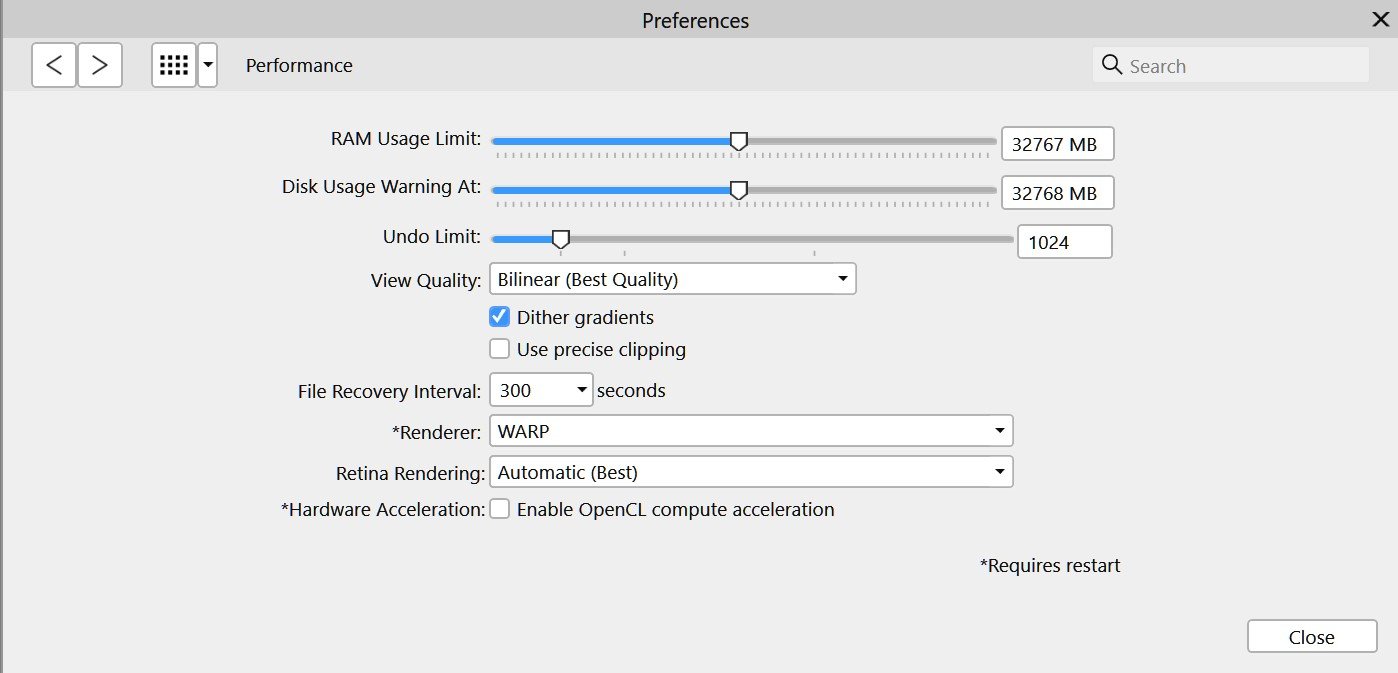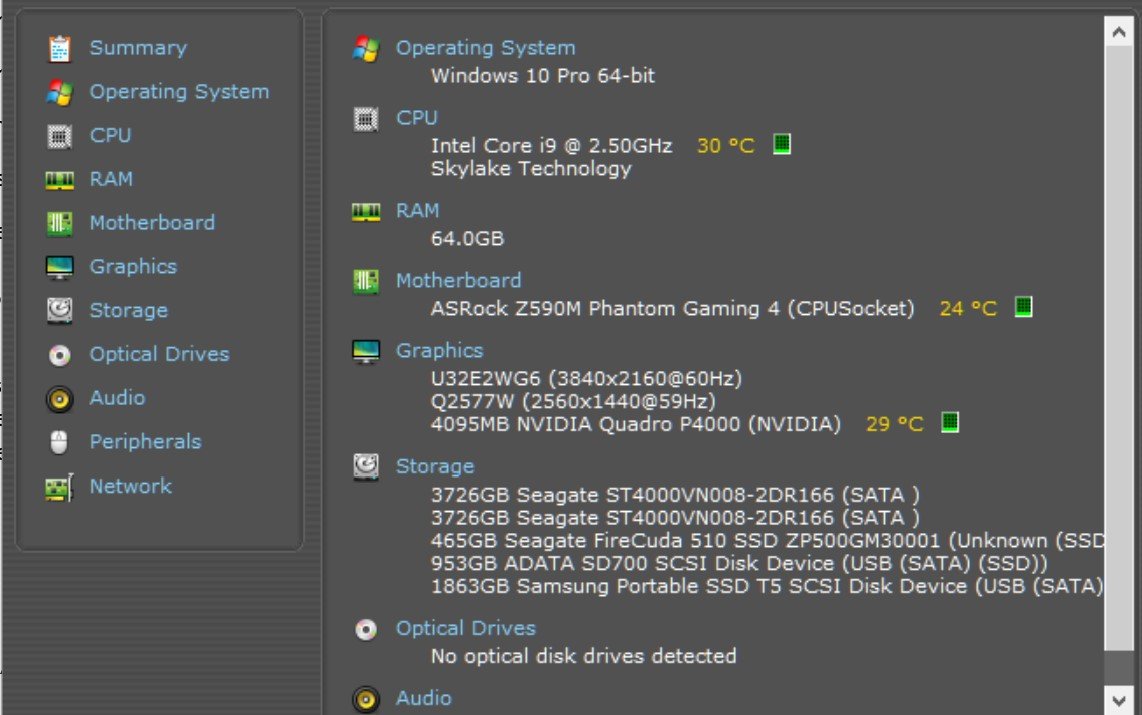Search the Community
Showing results for 'BSOD'.
-
Hi @Rafael_Morgan, Sorry to hear you're having trouble with this document. Firstly, I understand this is an important issue to you - but please do not post a thread on the forums, email the support team and directly DM a moderator simultaneously when requiring support. This can mean multiple members of the support team are trying to solve your issue across different methods (often without being aware of the others efforts) and can actually decrease the speed at which we're able to assist. Thanks for your understanding here. Secondly, the Affinity apps aren't able to cause a 'Blue Screen of Death' in Windows, as they are user-mode applications. Only kernel-mode applications (i.e. drivers) are capable of this. Applications, including Affinity, make use of these drivers which is why it appears some "applications cause BSOD", but in reality the application itself is unable to cause this, but might have been the trigger. Inspecting your document within a HEX editor, I can see that a large amount of the data within the file is missing, indicated by a '00' HEX value: It's likely due to this BSOD that the file was not written successfully and the data corruption occurred - unfortunately our team are unable to recover completely missing data, as it simply is no longer present in the file, our apologies. As above, we recommend creating regular backups of any documents you are working on, as unexpected issues may occur and are unfortunately out of our control. I would also recommend checking the Event Viewer / System logs on your PC regarding the BSOD that occurred, as this can indicate driver / Windows corruption or in worst case scenarios can be an indication of failing hardware. I hope this clears things up and our apologies once again we can't assist further here with your file.
-
Hello! Please forgive me if there are some expressions that are not correct because I am translating Japanese text. Bug Description BSoD occurred when moving the layer level adjustment window of Affinity Photo2 to another screen. I disabled the hardware acceleration function, but it had no effect. Environment where the bug occurred Monitor1:LG 27UP650 (3840x2160, DisplayPort) Monitor2:Wacom Cintiq DTK-1660 (1920x1080, HDMI) Monitor3:LG 22MP68VQ (1920x1080, DVI) CPU: AMD Ryzen7 3700X GPU:AMD Radeon RX580 (DriverVersion:22.20.27.09-230330a-390451C) Memory:32GB OS:Windows11 Home (Version:23H2, Build:22631.2715, Lang:Japanese) Application:Affinity Photo2 (Version:2.3.0) Stop Code:UNEXPECTED_KERNEL_MODE_TRAP How to reproduce the bug Open a PSD file in Affinity Photo2. Open the Levels Adjustment window. Move the level adjustment window displayed in Monitor1 to Monitor2. While the window is being moved, if the mouse cursor is on the Windows taskbar, the level adjustment window will move violently and BSoD will occur. movie.mp4
-
Again, Affinity may be the trigger of this issue - but certainly isn't the cause. As above you can find out further information on your system as to the cause of this crash at kernel level. If the PC has crashed to a BSOD, all active data is lost. This is unfortunately not something Affinity can control or change. Affinity does include an Autosave file recovery system for if the application has crashed and not the OS - though this should not be relied upon as a backup method. The app will have been unable to create or retain an 'autosave' file when the BSOD occurred, as these are temporary files which are removed when the PC restarts, in order to not retain unwanted space on your drive.
-
The "bug" itself is real, because I've reproduced the dialog issue a number of times without generating a BSOD. In most of those instances, my CPU was put under substantial load (lots of noise). There's video in this post. (not of the noise, though) Well, at least until now there was no BSOD... I was working in Publisher just now and it opened on the wrong screen as things tend to do sometimes on Windows 10. I moved the Text Frame dialog back to my bottom screen, or at least tried to, and it did the jumpy screen tearing animation and I received the same BSOD: I'll probably run Memtest just in case overnight, but that's too much of a coincidence to blame it 100% on hardware, imo. If I'm honest, the framework Affinity is built upon as it relates to multimonitor/multiDPI setups has been anything but smooth. I've reported numerous bugs on this over the years. (This isn't a rant, I'm just stating what is relevant to what I've experienced within the context of reporting issues with DPI scaling) Taking a look at the BSOD, mine has the same parameters as OP: Their BSOD below: Microsoft describes this as the following: S: https://learn.microsoft.com/en-us/windows-hardware/drivers/debugger/bug-check-0x7f--unexpected-kernel-mode-trap Funny enough, MS seemingly contradicts itself here on the same page... More list of causes from Windows Report: S: https://windowsreport.com/unexpected_kernel_mode_trap-windows-10/ It's worth mentioning I've noticed more recently my EV is littered with Unhandled Exceptions from Affinity software that it seems don't alert the user: My own PC has only had 5 BSOD (earliest is back in Feb) occurrences this year. This is something I watch for because I am undervolting my PC. One for sure I caused by unplugging something (I forget what, it was very uneventful) and the other 3 were NVIDIA HDMI AUDIO related. Only the one is related to this. While I would not rule out defects in RAM or even my undervolt adding to or making myself more prone to BSOD, I doubt that both BSODs on very different machines can be put down to the same hardware failure. Absolutely software can cause BSODs, they're just typically driver-related and software is more rare. Also, since both OP and I have experienced it before moving panels between displays with the exact same visual defect, it seems reasonable there's a software correlation. Both OP and I are using AMD and NVIDIA GPUs, so it can't even be blamed on manufacturer-specific GPU drivers... Ask yourself, why should moving a single panel cause the CPU to suddenly run at high load? I've never seen this issue on any machine. My own experience with multi-monitor setups otherwise has been generally seamless with Windows 10 (and I expect Windows 11/12 as well when I upgrade). Edit: Memtest passed.
-
When it happens so often, some more details would be welcome, eg. the Affinity crashlog, entry in Windows Eventviewer at the time of the crash, details about your OS (which build), which graphic card with which driver version, a screenshot of BSOD....
-

Affinity Suite: Error Management
debraspicher replied to dlampel's topic in Feedback for the Affinity V2 Suite of Products
There is currently a bug which doesn't always result in a BSOD, but it pounds the CPU really hard when it is set off locking up the machine at least temporarily while it "recovers" from a DPI/monitor switch. The OP in that thread has a good example video where it shows how the panels visually glitch out and this can be reproduced reliably with certain dialogs/panels. It seems to be caused when those "problem" panels are moved between screens in mixed DPI environments. Only certain panels will trigger this behavior (I have managed to trigger a BSOD with Text Frame, as an example). So I can believe there is a connection with "off screen" panels leading to odd performance issues, like in your situation, especially when they are being somehow modified by the user on a different screen. Multi-monitor/mixed DPI scale behavior in Affinity can unearth some rare problems. I have some bugs related to this reported that are yet to be fixed in this category. These are pretty major bugs, in my own opinion, as they show broken scaling behavior relative to the OS' scaling (whether mixed DPI or not)... and as such, I'm forced to run my main screen below 150%, therefore reducing readability across the system... Therefore I would suggest you could maybe test the following if you see reason to do so... 1) Adjust both screens to share match DPI if they are not already set that way... 2) Lower your DPI at least below 150% if you have it set that way on either screen... -

How do you set priorities?
debraspicher replied to anto's topic in Beta Software Program Members Area
I'd like them to fix far more bugs than they're doing currently rather than worry about user-elected development cycle(s)... the bugs are a huge turn-off to using the programs and even though I really don't want to as these are the programs I prefer, I'm having to consider other options lest I end up in a situation where I can't use the programs... as it is currently, I have to lower my DPI on my displays to even use Pixel Mode properly. And then there's the BSOD caused by moving certain panels between displays to another (otherwise my computer is a very stable President). I'm not so concerned about future BSODs, but the laissez faire approach towards the growing bugs list is a major red flag... * -

2.1.0 Photo/Designer crashing all the time.
Chris B replied to Rafael_Morgan's topic in V2 Bugs found on Windows
We are either looking at an isolated software bug causing a crash which we need to pinpoint or the software is calling a driver which is faulting and leading to the BSOD. As I mentioned above, we cannot directly cause a BSOD—it's impossible. We can absolutely call a driver and cause it to fault which leads to a BSOD. I'm mostly interested in the fact you are passing the documents between the apps. Do you store your files locally or on an external drive/cloud? Does Windows Event Viewer show anything for the BSOD? -
Hi kwnobu, I'm afraid A BSOD can't be caused by an (user-mode) application, only a faulty driver/hardware. "Bug check 0x7F typically occurs after you install faulty or mismatched hardware, especially memory, or if installed hardware fails." https://learn.microsoft.com/en-us/windows-hardware/drivers/debugger/bug-check-0x7f--unexpected-kernel-mode-trap Lee
-
I've reproduced this. This UI bug also occurs on my machine. There's no BSOD, however. The CPU and GPU %'s rise considerably when the UI fails to change DPI, meanwhile my fans can be heard... 自分のパソコンでもこのUIバグもあります。BSODが起こってません。UIのDPI変わりが落ちると, CPUとGPU%ももっと高くようになるし、ファンの音が聞こえます。 23.12.04_07-55-50-PM_NV12_1920x1080.mkv
-
Welcome to the Affinity Forums @bobbles1 & I'm sorry to hear you're having trouble. As previously confirmed in this thread: The Affinity applications aren't able to directly cause a BSOD error - however it's certainly possible the app is using hardware/software that other apps aren't using, which triggers the issue within Windows. I'd recommend also using Windows Reliability Monitor as this may contain more information as to the cause of this, however the error messages/event viewer screenshots provided do seem to point to a potential hardware issue. It may be the internal iGPU within your Intel CPU causing this issue, so please make sure these drivers are also up to date, alongside your Nvidia drivers. Equally, please check for any BIOS updates from the manufacturer, as these can also reduce BSOD errors. I hope this helps!
-
As a new user, I was really hoping Affinity Photo would release me from Photoshop after twenty two years. Sadly, it looks as though it’s not going to happen. Every time I open AP, I can work for ten minutes or maybe an hour before the software crashes and I get a BSOD, this is usually a CLOCK WATCHDOG TIMEOUT, there has also been MACHINE CHECK EXCEPTION and WHEA UNCORRECTABLE ERROR. The BSOD can occur when performing even the simplest tasks such as using the Selection Brush or copying and pasting a selection. I have methodically been through and tried every suggestion offered in the AP forums and online, I have methodically been through and tried every option in Performance Preferences. The longest time the software worked - about an hour - was running it in Windows 8 compatibility mode, with the renderer set to WARP, Precise Clipping disabled, and CL disabled. FYI I do not have Capture One installed. Desktop tower specs - more than enough power and memory in all respects - are as per the attached screenshot. I also attach the latest crash file. ac59a3e8-40c1-454e-a20b-c48b16e17d94.dmp To rub salt into the wound, I have just finished a six-hour Photoshop session without a hitch. I sincerely hope there is a solution/fix, if not, I will no option but to uninstall AP for the last time and carry on with PS. Richard H
-

Downloading Affinity Photo V1
Dan C replied to Twostamps's topic in Affinity on Desktop Questions (macOS and Windows)
Hi @Twostamps, Welcome to the Affinity Forums I can confirm that the download from your Affinity account is still the correct link to use - though just to be certain that the downloaded file is not incomplete/corrupted I would recommend trying to redownload the latest version of V1 from the following link: https://store.serif.com/update/windows/photo/1/ I can also confirm that the Affinity apps are unable to directly cause a blue screen, as user-mode applications are unable to trigger a BSOD event. This is almost always caused by defective drivers, hardware or Windows files. What does the BSOD show, when the PC crashes? -
Hi @storrya, It's worth noting that the Affinity apps can be quite hardware intensive dependant on what's being done, and performing particular actions in the app (E.G Exporting, Merging, Rasterising) can put additional strain on your hardware which can then expose underlying issues on a Driver/System/Kernel level with your device, the apps themselves are not capable of causing a system crash/BSOD as they are only user level, meaning when they crash they don't take the whole system down with them. These type issues can sometimes be difficult to diagnose due to the number of variables but i've included some points below. Since your system/device is crashing it's highly unlikely that any app crash reports would generate from this, but a good place to start would be checking back in the Windows System event viewer logs at the time of the crash, additionally the Windows Reliability monitor may also provide some insight on what's happened. The system may be automatically turning itself off for hardware protection, so there are other variables to consider: - If certain components (E.G CPU) reach certain temps this can force an automatic system shutdown, performing hardware intensive actions in affinity would trigger an increase in temps that could lead to this. - Bad/unstable overclocks applied to the CPU/RAM can force a shutdown. - Faulty hardware drivers can lead to system instability, such as Graphics card drivers that may need re-installing updating.
-
Since it is causing a BSOD (blue screen), you would need to diagnose that first, separate from Affinity. You can check through Event Viewer (right click on start button) and may even see other errors pop up to this effect. https://www.thewindowsclub.com/find-and-view-bsod-log-files-in-windows-10-event-viewer Here I linked an article with a program that can be downloaded to analyze the dump file. It will tell you which file on your system generated the crash. (Edit: If you see it in Event Viewer, you can skip this step) You really just need the file causing it and to search to see what may have triggered the crash. Usually, it's a bad driver. https://www.tomshardware.com/how-to/fix-windows-bsod Edit: If the BSOD is linked to a graphics drivers, then please follow the DDU+GPU reinstall suggestion from my prior post. You will need to install for both your Intel onboard graphics and the NVIDIA GPU as well once you use DDU to clean old drivers from your system.
-
Hi @MWOO, It's worth noting that the latest available version of Designer 2 is the 2.2.0 Release build rather than the beta apps which are behind, so you may want to consider switching back over to the release apps. If you're referring to the stroke PT value failing to update when moving the slider this is currently logged with the developers, I've bumped it with your report. The affinity apps will the memory/resources as is required to complete the export process, dependant on the overall size of your exported file this can put additional strain on your hardware. If your entire system crashes outright then this suggests there may be something going wrong on a Driver/Kernel/System level with your device. If you're getting a BSOD you may be able to look into potential causes online via the Stop code it provides, or looking in the event viewer system logs. Another option to monitor this is the Windows Reliability monitor to see if that gives any further info. Equally, there could be a problem with out of date GPU/iGPU drivers causing issues, the motherboard BIOS version may need updating or if there's any CPU/RAM XMP overclocks applied they could be unstable so would need reverting.
-
Hello, I just purchased Affinity Photo (current version) on my system and have been in a few days encountering already 2 BSOD. I cannot reproduce this issue which has been appearing randomly while editing Fuji XT2/XH1 raw files. 1st time was when switching to liquify mode, 2nd time was when shifting the clarity cursor (before clicking develop raw). The BSOD message does not refer to a specific file (as I understand it may happen with Affinity Photo based on other posts I read) but mentioned: IRQL NOT LESS OR EQUAL (first BSOD) PAGE FAULT IN NON PAGED AREA (second BSOD) I am using the last version of Windows 10 1909 with last proposed updates installed. I know these kind of issues often relate to faulty hardware (ram, ssd) however, my system is quite recent (1 year old), very stable, and I have never encountered a single BSOD since I built it. This occured only twice and while using Affinity Photo. Thank you for your assistance. Maxime
-
I have new Surface Laptop 2 with the latest Windows 10 Pro. Tried Affinity Designer trial version from the Microsoft Store, liked it and purchased the full version from the Microsoft Store. The trial version worked fine, without issues. The full version was installed as a second version, leaving the trial version visible. That was slightly annoying, so I uninstalled the trial version. This may have caused some registry errors. When starting the full version of Affinity Designer, the Blue Screen Of Death (BSOD) emerged after five seconds, referring to cldflt.sys. Uninstalling and reinstalling the AD did not help. Followed one cldflt.sys fix and changed using regedit the DWORD value of Start from 2 to 3. No help. Changed Start value back to 2. Noting from the other topic in this forum that the bug may be related to OneDrive, I refreshed the OneDrive connection -> the Designer application started without the BSOD for the first time. Now the AD causes BSOD sometimes when trying to open or save files from the OneDrive. Many users have complained similar situations and the response has been similar - AD cannot crash the system. But that is exactly what it does. I have not experienced BSOD with any other applications in three years with my business laptops. Disabling the OneDrive is not an option as I have to make my living with this system. The OS is a fresh install for the new laptop, so I cannot remove any earlier updates. What could be the root cause for the cldflt.sys error? Which register values should work with AD? Could this be related to the response time from OneDrive?
-
Of cause they can result to and initiate BSODs, so you better don't repeat that statement in this general misleading way! A bad (or intentionally) way coded app accessing common drivers (drivers are just software too, like GPU drivers etc.) can yield to a BSOD. Games that stress the hardware memory & GPU drivers to much can yield to BSODs. Computer virus or another type of malware can cause a blue screen crash. Manipulating registry entries the wrong (or intentionally) way can yield to BSODs. You can also manually trigger a BSOD on demand for certain purposes, like checking the behavior of your developed software in such cases etc. See just related some few of the many related references here: Malwarebytes NotMyFault <- an app/program for such purposes How to manually trigger a BSOD How to trigger a Win 10 BSOD on demand ... and so on ...
-
Dear Dan C, Thank you for the information about the Reliability Monitor and suggestions. The attached reports make interesting viewing, prior to installing AP & AD on 23 May 2022, the reliability picture is good with only minor blips, two concerning Acrobat Notifications which I can’t remember even noticing. After AP & AD installation the days are full of critical problems. There were three calm days, 27-29 May, but this was due to using Photoshop to finish a work project, and not touching AP. Yesterday, Monday June 6, I thought for a while I had finally found the BSOD solution. Going through the Affinity Forums again, I came across one concerning problems caused by a graphics tablet, and that unplugging it solved the trouble. I duly unplugged my wireless Intuos Pro L, and just to be sure, all external drives and ShuttleProv2 controller as well. Result? Both AP & AD worked well for most of the day, until that is, when opening an image in AP and simply adding brightness and contrast to it, bang, BSOD #1 CLOCK WATCHDOG TIMEOUT (fatal hardware error). Restarting, I opened the same JPEG image did the same brightness action, BSOD #2, restarting again this time trying a different image with a simple object selection, BSOD #3. Just to be clear, the images I used when the BSODs occurred were the same as those used when AP was working perfectly earlier in the day. So, the tablet theory was not the hoped for answer after all. FYI I have double checked, all drivers are up-to-date, Windows updates are current. My crash logs are automatically sent to Affinity.
-
Hi, I've just bought Affinity Photo on the Microsoft store, installed fine but has not started up once correctly. The splash screen loads, then I get a BSOD - every time I've tried to run the application. It's reporting cldflt.sys as having failed. I'm on a Microsoft Surface Pro (5th Gen) Windows 10 Pro Version 10.0.18362 Build 18362 I have designer and it starts and runs fine. I tried running Microsofts DISM Tool and SFC tool as described here: https://support.microsoft.com/en-gb/help/929833/use-the-system-file-checker-tool-to-repair-missing-or-corrupted-system Both completed successfully, Photo still causes BSOD Read it might be linked to OneDrive - Tried exiting OneDrive, still get BSOD This is really dissapointing for a £50 new purchase.
-
Not impressed! This is the first time I've ever had BSOD on Win10 and Affinity Designer just did it twice trying to dock a pop out menu. Yes I'm using the latest version Yes I can recreate, it happen twice in a row doing exactly the same action. Its' only happened in the one document, but not willing to keep killing my OS just to test that. System details: Windows 10 Pro - latest updates etc. What happened? - It killed my OS and forced a restart, what did I expect... Not that! Steps to recreate: Load document Try to drag pop out tabs for character and paragraph options to be docked around the bottom right corner of the screen The menu will start to stutter, the system will lock up and then the OS will exit to the BSOD forcing a system restart. Screenshots: I could record on my phone but I'd rather not keep blue screening my system unless absolutely necessary. No unusual hardware Did it used to work? - Don't know
-
BSOD on save for new and already existing files
aaaaaaaaa posted a topic in V1 Bugs found on Windows
Hello, I've come across an issue in which Publisher seems to be crashing Windows upon trying to save a document. I'm guessing that it's due to some update that Microsoft released over the weekend as everything was fine last week and nothing else that I know of had changed. To reproduce: Open Publisher Create a new document or open an existing document Attempt to save After choosing a location and name and pressing the save button, Windows crashes. The BSOD claims that cldflt.sys failed, giving a stop code of SYSTEM_SERVICE_EXCEPTION. The file does end up getting created, but trying to open it afterwards gives a "file type not supported" error. The bug happened every time I tried to save, regardless of whether the file being saved was already in existence or new. A little poking around on the web suggested that uninstalling cloud services might help, so I tried removing OneDrive and sync services with Google. This did nothing. In the end, the only thing I was able to do to get everything working again was to roll back to a backup from before this weekend's OS updates happened. The provided file is what was produced from one occurrence of the issue. Thanks, Dan. Test.afpub -
Just FYI, I rebooted my Windows 10 laptop this morning to finish installing Windows update KB4517389, and after that I experienced several Windows failures, BSOD when using the menus in the Affinity applications. Once in Photo (don't remember what menu I item I clicked) and twice in Publisher using Text > Show Special Characters. The failures pointed to ddflt.sys (or, perhaps, cldflt.sys) After removing that update things are working smoothly again. I understand that it is most likely an error in that Windows Update, and not in the Affinity Applications. I am not finding anything via Google (yet) about errors in that update.
-
We've had users report that when trying to launch our apps on Windows they're getting a Blue Screen of Death message relating to cldflt.sys. This is also affecting other apps including Microsoft's Visual Studio as reported on the Microsoft Developer Forums. This BSOD error started appearing after Microsoft released the Windows 10 KB4517389 update. Microsoft released a Windows 10 update on 10/12/19 (KB4530684) which includes the below fix. Please download and install this update and try opening the Affinity app again to see if your issue is resolved. Addresses an issue that might cause error 0x3B in cldflt.sys on some devices.












